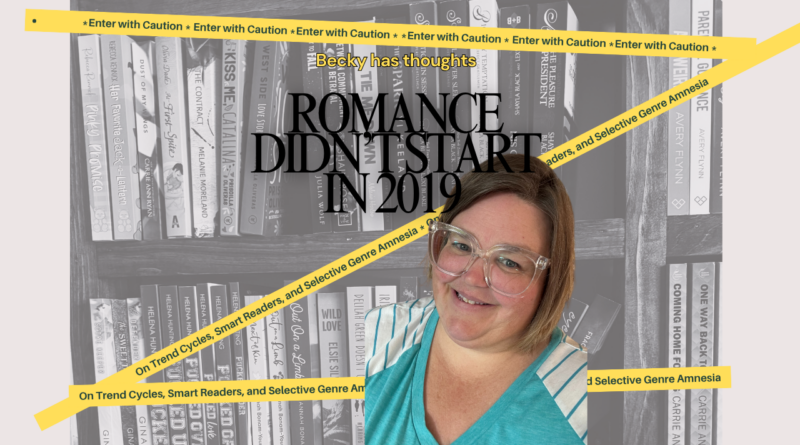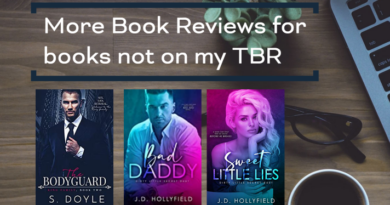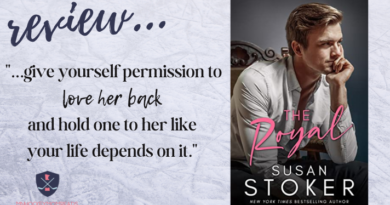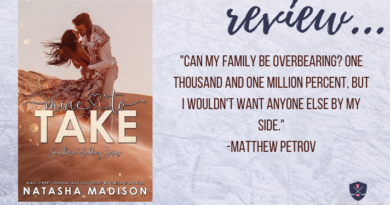Romance Didn’t Start in 2019: Why Genre History Matters in a Hype-Driven World
For the past few years, I’ve watched something shift in Romancelandia. The conversation has gotten louder, faster, and increasingly driven by trend cycles, viral moments, and “must-read” lists that reset every 90 days. I love new readers and fresh enthusiasm—God knows the genre thrives on it—but I’m also noticing a strange, creeping side effect:
It’s as if publishing thinks the romance genre began the day TikTok discovered it.
And as someone who’s been reading, reviewing, blogging, and evangelizing romance long before the algorithm learned the word “spice,” I’m here to say: romance didn’t start in 2019. Not even close.
Romance didn’t just appear—it survived. It evolved. It reinvented itself over and over, often without respect, support, or acknowledgment from the broader literary world. And if we’re going to keep building this beautiful, chaotic, trope-filled community, then we need to stop acting like everything “started” with the latest trend.
Romance Readers Have Always Been Smart, Vocal, and Loyal
Before BookTok, BookTube, and Bookstagram, there were:
- Library romance clubs
- Message boards and Yahoo groups
- Harlequin subscriber circles
- Review blogs and early podcast communities
- Romance conventions and reader retreats
- Fan-run Goodreads ecosystems
Romance readers have always discussed craft. We’ve always analyzed tropes, character arcs, consent, feminism, sexuality, and genre expectations. We were doing longform critical conversations while TikTok was still trying to figure out transitions.
So no—smart romance readers are not new.
What’s new is who publishing listens to, and how short the attention span has become.
A Quick (But Important) Timeline of Modern Romance
To understand why this matters, you have to understand the timeline.
The 1980s: The Mass Market Boom
This is where modern romance went mainstream. Waldenbooks and Borders had entire romance walls. Category romance exploded. Authors like:
- Johanna Lindsey
- Julie Garwood
- Judith McNaught
- Beverly Jenkins (late 80s, early 90s)
were selling millions and shaping reader expectations. Westerns, historicals, and family sagas dominated. Romance funded whole segments of publishing—even then.
The 1990s: Diversification and the First Superstar Era
The 90s brought:
- More contemporary romance
- More rom-com energy
- The rise of paranormal
- The earliest push for more diversity in storylines
This is where westerns, small towns, and cowboy series cemented themselves. Yellowstone did not invent cowboy romance. It simply re-sparked mainstream curiosity about a subgenre that never left.
The 2000s: Sports, Paranormal, and Series Obsession
Enter the early sports romance wave—especially hockey and football. As paranormal boomed (hello vampires, shifters, and demon boyfriends), romance also saw:
- Rachel Gibson’s sports romances
- Deidre Martin’s hockey romances
- Susan Elizabeth Phillips’ Chicago Stars
- Early Suzanne Brockmann romantic suspense
Many of today’s “trending” concepts are literally built on this era’s foundation.
The 2010–2016 Era: The Indie and Ebook Revolution
This era changed everything:
- Self-publishing broke open the market
- KU entered the scene
- Serial romance soared
- Romance blogging and Goodreads guided the community
Contemporary, sports, small-town, and erotic romance thrived because readers—not publishers—drove discovery.
2019–Present: BookTok + The Algorithm Era
Now we’re in the hype-driven cycle:
- Viral moments dictate buy-ins
- Backlist gets ignored in favor of “whatever’s trending”
- New readers enter without context
- Publishers chase tropes they don’t understand
- Authors feel pressured to please the newest, loudest voices
And suddenly, I’m seeing takes like:
- “Hockey romance is a new trend!” (No.)
- “Western romance is back for the first time!” (Also no.)
- “Romantasy is finally here!” (It’s been here since McKinley, Lackey, and LKH, my friends.)
This genre has amnesia by convenience.
Trend Chasing Is Not Genre Literacy
New readers are wonderful. Bring them in. Hand them books. Give them a library card and a binge list.
But trend familiarity is not the same as genre understanding.
When we erase the past, we:
- Repeat discourse that was settled 20 years ago
- Reinvent tropes badly
- Flatten subgenres
- Value virality over craft
- Forget who built the damn house
You cannot celebrate the genre while dismissing its legacy.
There’s Room for Every Reader—But We Must Respect the Roots
Romance thrives because it has history, longevity, and community. Not because of one platform, one author wave, or one hype cycle.
If you’re new, welcome. Truly. Stay. Explore the backlist.
If you’re a long-time reader, keep your voice loud. You matter.
If you’re an author, know your lineage—not because you owe the past your loyalty, but because it makes your writing stronger and your understanding deeper.
Because Here’s the Truth
Romance is not having “a moment.”
Romance is the moment. It always has been.
And if we want the genre to keep growing—ethically, creatively, and sustainably—we have to honor the foundation while we build what’s next.



